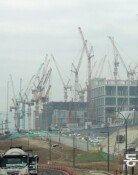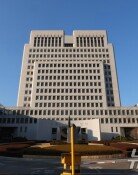Yongbyon nuclear reactor could yield weapon-grade plutonium
Yongbyon nuclear reactor could yield weapon-grade plutonium
Posted October. 05, 2023 08:23,
Updated October. 05, 2023 08:23
The South Korean and U.S. intelligence authorities have reportedly detected signs that a 5-megawatt reactor at North Korea's Yongbyon nuclear facility has been recently suspended. The two authorities are closely monitoring the situation, believing that it may be related to reprocessing spent fuel rods to extract plutonium for nuclear weapons.
According to sources for The Dong-A Ilbo on Wednesday, Seoul and Washington have used various reconnaissance assets to detect that the 5MW reactor in Yongbyon was suspended late last month. The active operations of the reactor, which was confirmed to be restarted in July 2021, were detected by US reconnaissance satellites, but its operations reportedly stopped in late September.
"The U.S. and South Korean authorities believe it could be a sign of reprocessing work to obtain weapons-grade plutonium," a South Korean government source said. Reprocessing involves shutting down a reactor for several weeks or longer, removing the spent fuel rods from the reactor, and transporting them to a radiochemical laboratory. And eventually reactors should be underwent a chemical process to extract weapons-grade plutonium.
The 5 MW reactor at the Yongbyon nuclear facility is North Korea's only weapon-grade plutonium production site. After the reactor is shut down, its spent fuel rods are removed and reprocessed to produce high-purity weapons-grade plutonium. Experts estimate that six to eight kilograms of weapon-grade plutonium can be obtained annually from the spent fuel of the Yongbyon 5 MW reactor. Since the reactor, whose operation restarted in July 2021, have been operated for more than two years, it could yield 12 to 16 kilograms of weapon-grade plutonium. This is a volume enough to make three to four 15-kiloton (kiloton is the destructive power of 1,000 tons of TNT) nuclear bombs, which were dropped on Hiroshima, Japan, during World War II. Given North Korea's advanced nuclear technology, it could actually produce a larger number of warheads.
North Korea's recent brazen display of signs of nuclear material production to South Korea and the United States, as well as the North’s detailed constitutional guarantee to upgrade its nuclear arsenal, could be explained by its intention to blatantly strengthen its nuclear arsenal in the context of the ‘South Korea-U.S.-Japan vs. North Korea-China-Russia’ neo-Cold War.
"We cannot rule out the possibility that North Korea will soon make a stronger provocation, such as a nuclear test, in an attempt to reverse the situation if there is no clear technical guarantee for the military reconnaissance satellite, which failed twice this year," a Seoul official said.
Jin-Woo Shin niceshin@donga.com
According to sources for The Dong-A Ilbo on Wednesday, Seoul and Washington have used various reconnaissance assets to detect that the 5MW reactor in Yongbyon was suspended late last month. The active operations of the reactor, which was confirmed to be restarted in July 2021, were detected by US reconnaissance satellites, but its operations reportedly stopped in late September.
"The U.S. and South Korean authorities believe it could be a sign of reprocessing work to obtain weapons-grade plutonium," a South Korean government source said. Reprocessing involves shutting down a reactor for several weeks or longer, removing the spent fuel rods from the reactor, and transporting them to a radiochemical laboratory. And eventually reactors should be underwent a chemical process to extract weapons-grade plutonium.
The 5 MW reactor at the Yongbyon nuclear facility is North Korea's only weapon-grade plutonium production site. After the reactor is shut down, its spent fuel rods are removed and reprocessed to produce high-purity weapons-grade plutonium. Experts estimate that six to eight kilograms of weapon-grade plutonium can be obtained annually from the spent fuel of the Yongbyon 5 MW reactor. Since the reactor, whose operation restarted in July 2021, have been operated for more than two years, it could yield 12 to 16 kilograms of weapon-grade plutonium. This is a volume enough to make three to four 15-kiloton (kiloton is the destructive power of 1,000 tons of TNT) nuclear bombs, which were dropped on Hiroshima, Japan, during World War II. Given North Korea's advanced nuclear technology, it could actually produce a larger number of warheads.
North Korea's recent brazen display of signs of nuclear material production to South Korea and the United States, as well as the North’s detailed constitutional guarantee to upgrade its nuclear arsenal, could be explained by its intention to blatantly strengthen its nuclear arsenal in the context of the ‘South Korea-U.S.-Japan vs. North Korea-China-Russia’ neo-Cold War.
"We cannot rule out the possibility that North Korea will soon make a stronger provocation, such as a nuclear test, in an attempt to reverse the situation if there is no clear technical guarantee for the military reconnaissance satellite, which failed twice this year," a Seoul official said.
Jin-Woo Shin niceshin@donga.com







